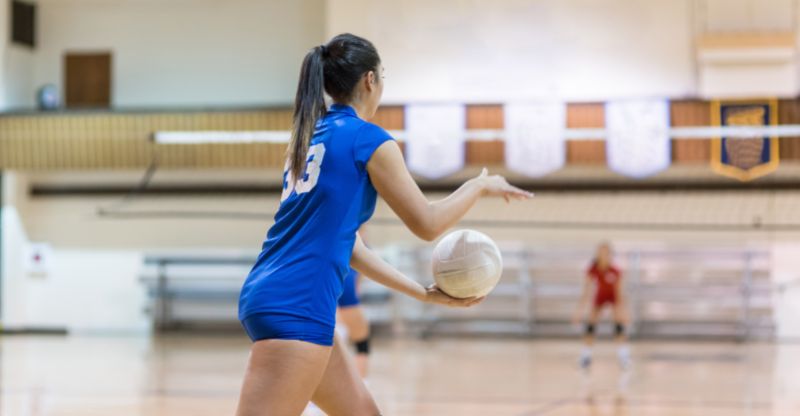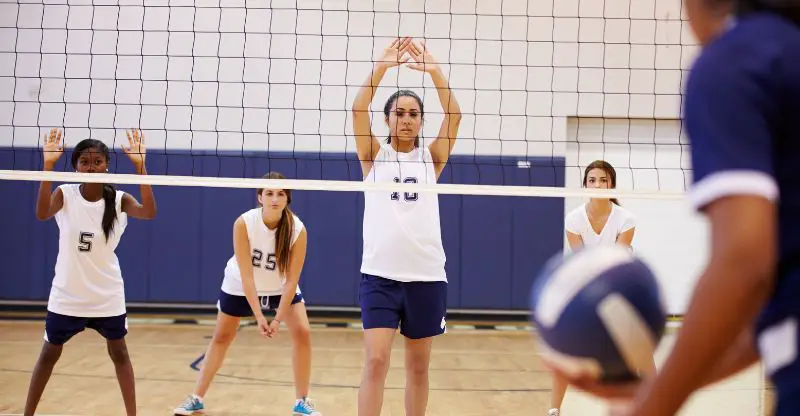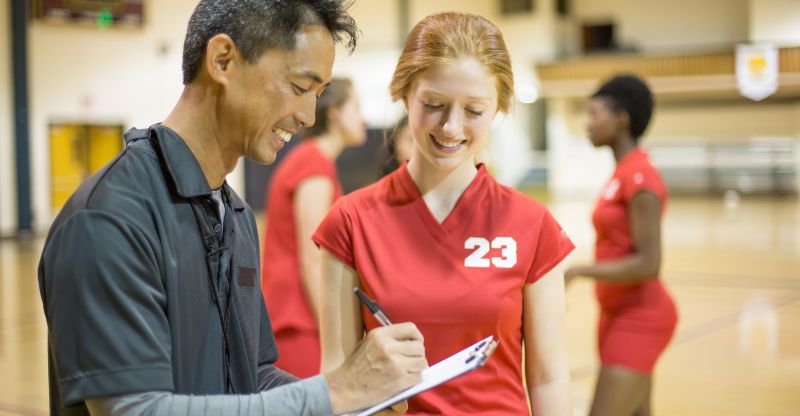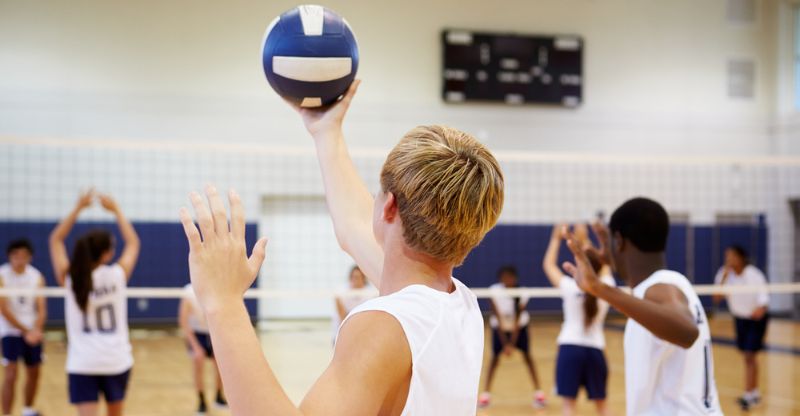As a pure defensive specialist, it’s no secret that the libero cannot spike or even play in the front row positions near the net.
However, under some volleyball regulations, the libero is still allowed to serve despite being banned from serving in the majority of the world.
The key is knowing your league’s rules.
So, can the libero serve in volleyball? Yes, the libero can serve in volleyball. However, only in specific situations. While under FIVB regulations liberos are unable to serve, under USAV and NCAA rules liberos may serve in one specific rotational position. The libero may also serve if there are six or fewer players total on a team, functioning as a normal player.
Not understanding when and where the libero can serve – or serving rotations as a whole – can lead to your team forfeiting free points to the other team and losing your serve. Using this correctly, however, adds another dimension of strategy for your team to help you win.
In this article, I’ll be discussing:
- Is libero serving allowed?
- History of the libero serving in volleyball
- Specific rules and exceptions to the libero serve
Is It Allowed For A Libero To Serve?

Under FIVB rules, governing the majority of the world, the libero is not allowed to serve in volleyball. This is the same at every level internationally, from elementary to professional levels.
However, a libero is allowed to serve under NCAA or USAV regulations, primarily used only in the United States.
The rules change slightly from level to level here, which I’ll explain below.
History of The Libero Serving In Volleyball
When the libero was first invented, it was banned from serving in volleyball. To understand why this was and why it changed, we first need to understand the role of the libero and why it was created.
The libero was first invented at the international level in 1998 in Italy, around the time that volleyball rules shifted to rally point scoring (as opposed to the “side out” scoring system in use until that time, which only allowed the serving team to score).
Due to the main strategy of men’s volleyball focusing on power and hitting strength alone, there was a loss of interest in men’s volleyball at the time due to the scoring system and the lack of excitement.
Women’s volleyball continued to draw crowds in the tens of thousands as they focused more on defense, resulting in longer and more exciting rallies.
In order to create more dynamic plays to rival the popularity of women’s volleyball, the libero was implemented as defensive specialist.
“Libero” means “free” in Italian, and could move anywhere behind the ten foot line and switch out at will, making the game more interesting and strategic.
Having been created purely for defense, the libero was banned from serving.
This changed in the United States in 2002, however, when the NCAA altered its regulations to allow liberos to serve to continue the idea of using the libero to make matches more interesting.
As of 2022, the rest of the FIVB has continued to ban liberos from serving.
Related Article: What Is A Defensive Specialist In Volleyball? An Overview
Libero Serving at Different Levels

Important: The levels detailed below exclusively deal with those in the United States, which allow liberos to serve. As the libero is not allowed to serve internationally, differences in level between countries will not be dealt with.
Can A Libero Serve In Middle School?
Liberos are rare to see in most middle school teams due to the complexity of the rules and the result of most coaches being volunteer parents of the players. Even with a trained coach, the use of liberos is limited at best.
When used, liberos tend not to serve at this level.
This is mostly due to allowing different players to develop their individual strengths paired with the height difference between players. It’s hard enough to serve over the net for players at this age, and coaches will let taller players with more power serve over their liberos most of the time.
No matter what position you play at this level, if you want more time to play on court, focus on improving your serve. It will be challenging, but incredibly rewarding in the long run as you continue developing as a player.
Related Article: How Is The Server Determined In Volleyball?
Can A Libero Serve In High School?
High school and club volleyball are the proving grounds of college hopefuls, and – by extension – anyone aiming to go pro.
It’s here that your skills will develop most over your four years, where you have the most freedom to experiment, and where scouts will determine your future volleyball career.
Needless to say, coaches will take every advantage they can get.
Liberos often serve at this level if their serving is better than the players they have switched out for.
This is less to do with the libero’s offensive serving power – although I’ve seen some killer libero serves in my time – but with the other player’s inability to serve consistently. Having the libero serve for them covers the risk of a service fault.
Similar to the previous level, if you want to play more at the high school level there’s one simple thing to work on: your serving.
Related Article: How To Read The Serve In Volleyball?
Can A Libero Serve In College & University?
The college and university level is where things get interesting.
While allowed to serve under NCAA regulations, liberos only serve if they give their team an edge.
Where liberos serve in high school to eliminate the risk of poor serves from teammates, there’s no need for such consideration at the college level.
Each player on the team knows what’s expected of them: their best.
It sounds severe, but there’s no room for bad serving games on the court.
Liberos typically serve at the college level if their serve is better than the teammate they have switched out for on a technical level, or sometimes to give them a serving break.
This level is all about tactics and efficiency, so using any method to throw the other team off-game can and will be explored by the coaching staff.
Can A Libero Serve In Professional Volleyball?
There is currently no professional volleyball league in the United States, or one that adheres to USAV regulations. This means that American collegiate athletes must look internationally to play, most often getting recruited into the Turkish, Italian, Korean, Japanese, and German leagues.
Because international leagues follow FIVB regulations, the libero is not allowed to serve at the professional level.
This also holds for major competitions such as the World Championships, World Cup, and World League.
The Olympics also follow FIVB format, resulting in the libero not being able to serve.
Can A Libero Serve In Social Volleyball?
Liberos serving at the social level should be left up to discussion between teams or the recreational managers who set up the match/tournament.
While most teams rarely feel the need to use liberos for the social level, there’s no downside to playing with either FIVB or USAV rules.
Choose the one best suited for both of your teams, and have fun!
Related Article: Can The Libero Be Captain In Volleyball?
Libero Serving Rules

Let’s now cover each of the rules associated with liberos based on the league:
FIVB
19.3 Actions Involving the Libero
19.3.1.2 He/she is restricted to perform as a back row player and is not allowed to complete an attack hit from anywhere (including playing court and free zone) if at the moment of the contact the ball is entirely higher than the top of the net.
19.3.1.3 He/she may not serve, block or attempt to block.
Takeaway: The libero cannot serve under FIVB rules.
NCAA/USAV
USAV 7.7.1: A rotational fault is committed when a Libero serves in a second rotation position in the same set.
Takeaway: Essentially, this means that the libero cannot serve in place of more than one player per set, as that would be unfair and be completely out of line with how the rest of the players serve.
USAV 19.3.1.3: a. The Libero may not block or attempt to block. b. In one rotation, a Libero may serve after replacing the player in position 1.
USAV 19.3.2.1: In one rotation, a Libero can replace the player in position 1 and serve the next rally, even if s/he is already on the court in replacement of another player. In this situation, the Libero does not have to exit the court before replacing the player in position 1, and there does not need to be a completed rally between Libero replacements.
Takeaway: Here, the libero – instead of switching with the back row player after their service points are concluded – simply switches with them immediately and takes the serve. While some referees insist on the libero exiting and re-entering the court in the libero replacement zone to do this, others don’t mind. Pay attention while executing this to not waste time and lose a point!
Exceptions
Some notable exceptions exist when it comes to libero serving that includes both FIVB and NCAA/USAV regulations.
In some situations, such as an injury or another situation reducing the number of “regular” (non-libero) players below six, the libero may be permitted to function as a regular member of the team and serve, play front court, and spike per normal.
In this case, their libero number must be rewritten into the team column if no regular jersey is available to wear.
Whether this change is permitted or not is up to the officiating referee, however.
The alternative to this dilemma is by counting the libero’s serve as an immediate fault when they come to serve and continuing play. Another compromise I’ve seen used is by exchanging the middle blocker and libero each front-back rotation so that the libero is always back and middle always front.
Communicate with the referee and your coach to come to a decision in this situation and decide what best to do.
Related Article: Substitution Rules in Volleyball (Complete Guide)
Final Thoughts
Whether or not liberos can (and should) serve has been the topic of much debate in the volleyball community. While the American volleyball community is the only place where this is currently allowed, the potential for implementation in other leagues is a distinct possibility over the next ten years, depending on public perception.
For now though, the libero cannot serve under FIVB regulations. Under USAV and NCAA rules, liberos may serve in one specific rotational position. Some exceptions exist under the referee’s allowance, and the libero may serve this way if there are six or fewer players total on a team, functioning as a normal player.
While this article has sought to give you a comprehensive understanding of the rules surrounding liberos serving, the best policy is to check with the referee before your match or the governing head of your league on their policy.
